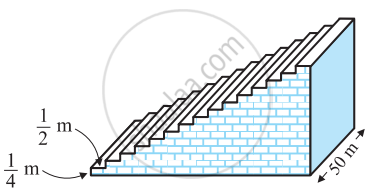Advertisements
Advertisements
Question
Solve the equation:
– 4 + (–1) + 2 + 5 + ... + x = 437
Solution
Given equation is,
– 4 + (–1) + 2 + 5 + … + x = 437
Here, –4 – 1 + 2 + 5 + … + x is in A.P.
Then, a = -4, d = -1 + 4 = 3, l = x
Given: Sn = 437
⇒ `"n"/2[2"a" + ("n" - 1)"d"]=437`
⇒ n[-8 + 3n - 3] = 874
⇒ 3n2 - 11n - 874 = 0
⇒ 3n2 - 57n + 46n - 874 = 0
⇒ 3n(n - 19) + 46(n -19) = 0
⇒ (n - 19) (3n + 46) = 0
⇒ n - 19 = 0, n = 19
⇒ 3n + 46 = 0
n = `-46/3` (Impossible)
Hence, n = 19
So, l = a + (n - 1)d
x = -4 + (19 - 1) 3
= -4 + 18 × 3
= -4 + 54
x = 50
APPEARS IN
RELATED QUESTIONS
If the term of m terms of an A.P. is the same as the sum of its n terms, show that the sum of its (m + n) terms is zero
In an AP, given a = 7, a13 = 35, find d and S13.
Find the sum of the odd numbers between 0 and 50.
A small terrace at a football field comprises 15 steps, each of which is 50 m long and built of solid concrete. Each step has a rise of `1/4` m and a tread of `1/2` m (See figure). Calculate the total volume of concrete required to build the terrace.
[Hint: Volume of concrete required to build the first step = `1/4 xx 1/2 xx 50 m^3`]

Find four consecutive terms in an A.P. whose sum is 12 and sum of 3rd and 4th term is 14.
(Assume the four consecutive terms in A.P. are a – d, a, a + d, a +2d)
Rs 1000 is invested at 10 percent simple interest. Check at the end of every year if the total interest amount is in A.P. If this is an A.P. then find interest amount after 20 years. For this complete the following activity.
If the sum of a certain number of terms starting from first term of an A.P. is 25, 22, 19, ..., is 116. Find the last term.
Q.10
In an AP, if Sn = n(4n + 1), find the AP.
An Arithmetic Progression (A.P.) has 3 as its first term. The sum of the first 8 terms is twice the sum of the first 5 terms. Find the common difference of the A.P.
